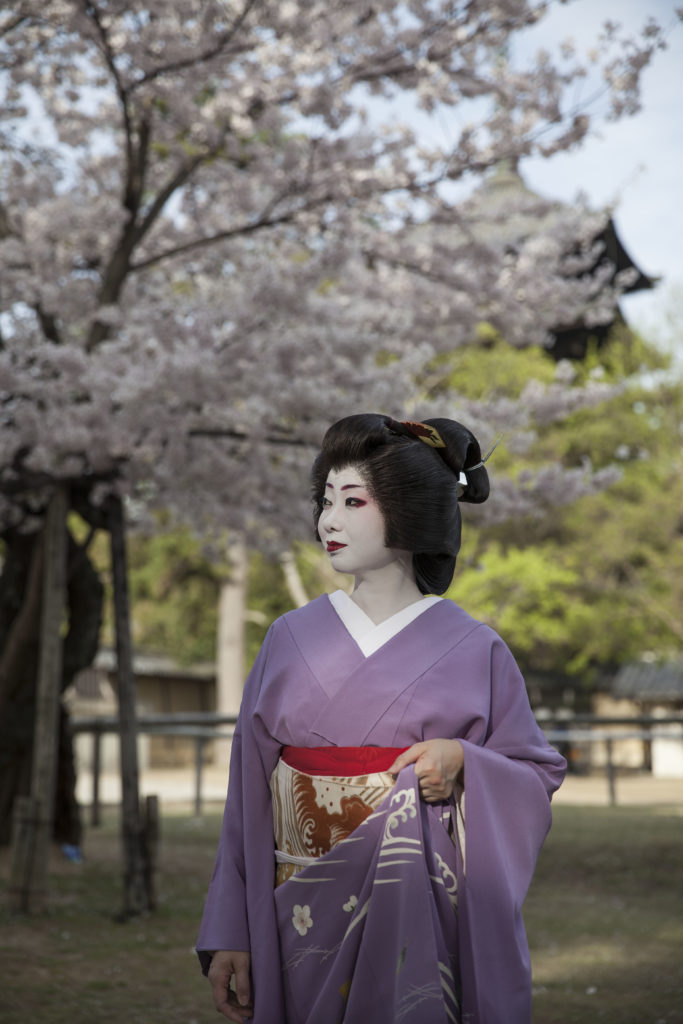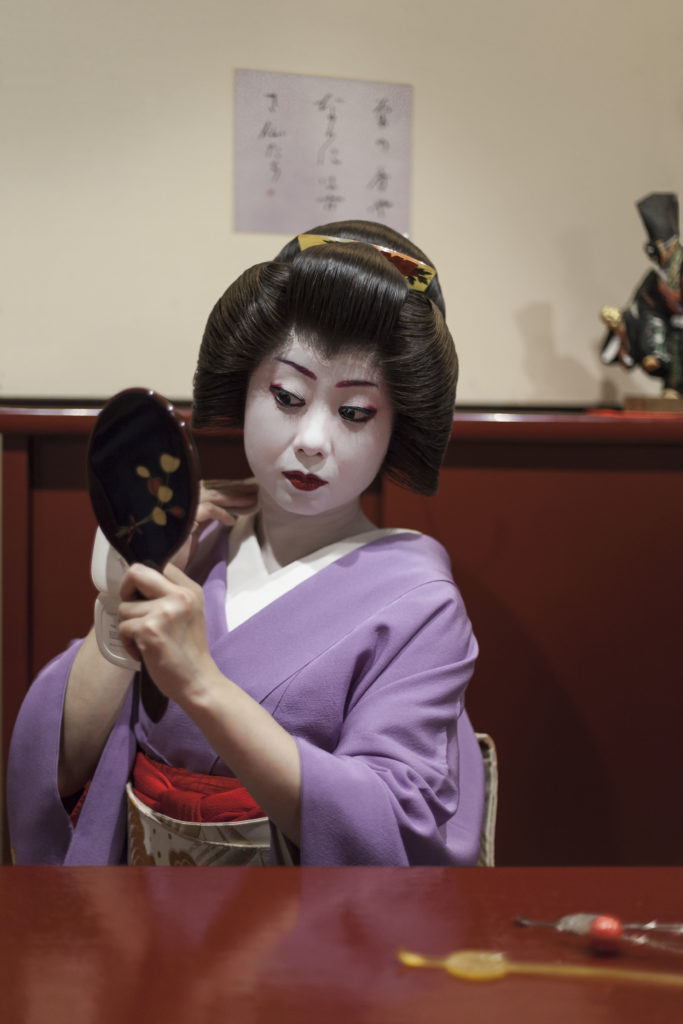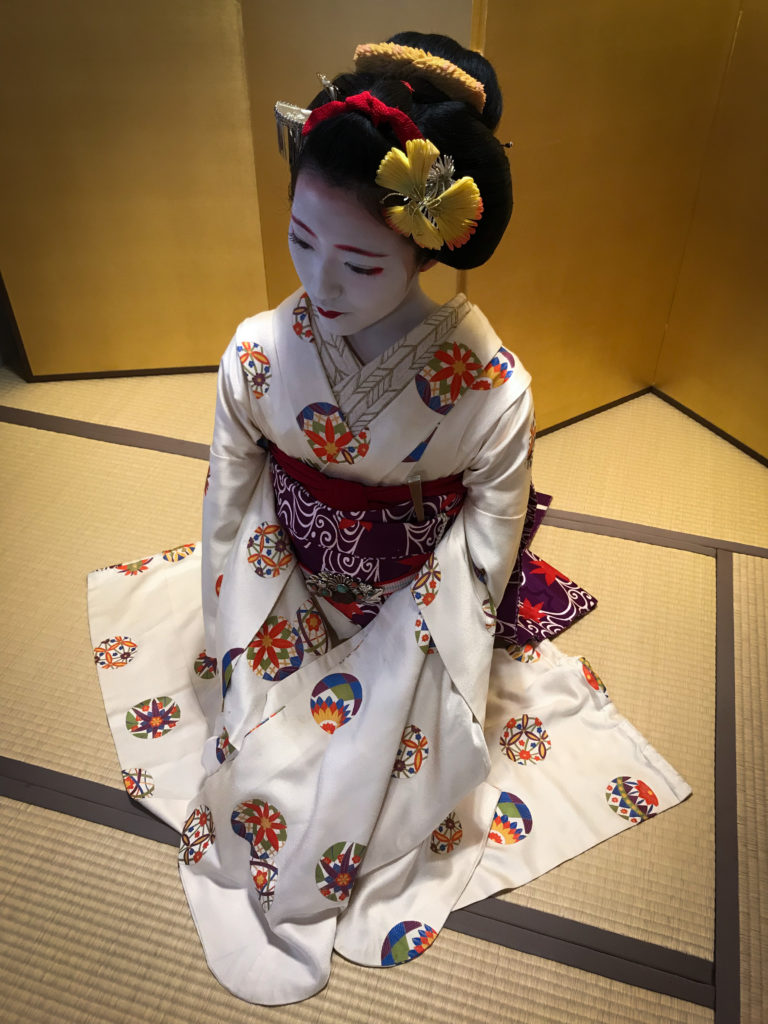
If you think of the word geisha you probably automatically think Kyoto. Understandable—Kyoto maiko’s image is one of the most popular symbols of Japan (I even did my own academic study confirming this thesis) and it’s so distinctive that it serves as a pattern of a unified geisha look.
But not far from Kyoto lies a real treasure: a small one-house geisha district in Nara, abundant with culture, traditions, and hope for a bright future. Let’s have a look inside.

Although Kyoto stuns me every day, as it unveils its traditions and history tiny drop by drop, I always feel extremely excited about going to Nara to visit Ganrin-in (元林院)—the very last hanamachi of the first capital. There is only one teahouse and okiya named Tsuruya and run by Kikuno (菊乃) who is the only one geiko in Nara at the moment.

Visiting Tsuruya for the first time was a surreal experience. I remember walking down the loud and busy promenade of Nara’s touristic center, leading to Kofuku-ji, one of the most significant local attractions. I took the right turn just at the Sarusawano pond and, suddenly, I felt like I was in a totally different city. Ganrin-in is a very tranquil area full of old tiny houses and narrow streets nowadays. Tourists get lost here sometimes when they take the wrong turn. It’s hard to believe that such a peaceful neighbourhood used to be a lively entertainment district with red lanterns hung under the rooftops. One of the elegant houses on the tiny street is the Tsuruya okiya. You can’t miss this building, as it has a really chic atmosphere even from the outside.

It’s hard to tell how many geisha were there before the war, but Nara might be a home for hundreds of them back in the Meiji era. Around the 30s-50s, Nara’s hanamachi became to depopulate rapidly, with the number of active geiko shrinking to 100. It was still a thriving business at the beginning of the 90s when Kikuno joined her okiya, at the age of 15. A maiko’s career wasn’t already a popular choice among Japanese teens. Even if they were interested in the traditional arts, it was much safer bet to stay in high school and in the end become an office worker and a housewife. But Kikuno’s aunt, a previous owner of Tsuruya, asked her to contribute to the dying culture of Nara’s traditional entertainment and the girl decided to give it a shot. She had no idea that, eventually, she would become the last geisha in the whole city.

Since her formal debut as a maiko in 1990, and then as a geiko around 1996, Kikuno, an Osaka native, has been fighting for the life of Ganrin-in. She recalls that she wasn’t the best student at junior high school and her teachers were worried if she’d be able to find any job at all. – Oh, here you just need to paint your face white, wear your hair in nihongami, wear kimono, and sit patiently, that’s it – her aunt told her. It sounded fun and, after many years of excessive training at the oldest Nara’s ochaya Kikusuiro, Kikuno was granted with the title of natori (master) of the Hanayagi school of dance (under the name of 花柳鷹 – Hanayagi Taka) in 1999 and a natori of the music school Mochizuki (望月太明賀寿 – Mochizuki Tamekazu) a year before. Getting such honors is a rare achievement and expensive process—not too many young geiko in Kyoto are able to call themselves natori. But becoming a natori, theoretically, should be the main objective of every traditional artist, especially the ones who perform the arts for the living. Practically, it’s a title reserved only for the most enduring geiko.

Kikuno inherited her aunt’s teahouse Tsuruya in 2007, as an accomplished geiko. But, unexpectedly, Kikuno became the only one and the very last geiko in Nara. The imminent threat of Ganrin-in becoming a mere piece of history made her realize that the future of hanamachi depends on the smart usage of modern marketing. She started her life project called the restoration of Nara Ganrin-in hanamachi with innovative online fundraising (2015) and gathered more than 1 million yen to revitalize the hanamachi. Although Kikuno debuted from Kikusuiro, it was no longer operating as an okiya. The Kiku-apprentices started to train under Tsuruya, formerly only a small teahouse, now the only one okiya in Nara. Tsuruya’s maiko, naturally, adopted Kikusuiro’s crest and Kikuno’s birth surname, Ono (大野). The new chapter of Ganrin-in history has launched. In order to protect her legacy, Kikuno was the first geisha to open up online for potential customers and to travel abroad (she rode the New York subway in full geiko attire, for example). As she operates alone, she has much more freedom than her Kyoto sisters. It allowed her to conquer the world with her unique business solutions.

Most importantly, Kikuno turned the traditional establishment into a standard company and her maiko became salaried employees. They sign a proper contract for the first three months of training and pay a fixed sum for the classes, food, and accommodation. After their official debut, they become regular workers with a minimum income of 155 000 yen and a room rent of 15 000 yen.


While it’s not much, it’s still a well-paid job for a young undergraduate, especially in comparison to the Kyoto maiko who receive a non-fixed amount of pocket money monthly (sometimes it’s 20 000 yen, sometimes… zero, depending on the situation and okiya’s management), but still, need to work as hard as their Nara friends. In general, the job in Kyoto is way busier and more stressful, yet no salary is granted for the maiko training.

This innovation at Ganrin-in attracted quite a few apprentices willing to study the Hanayagi school of dance under Kikuno. I was lucky enough to meet four of them in one year—Kikukame, Kikue, Kikumame, and Kikunami. Kikukame, who was the first geiko in Nara to debut in the 2000s, has already retired. The maiko, however, still continue to master the fascinating art of Nara, so different and unique than everything I learned in Kyoto.

Kikue (菊愛), now 20, is an energetic Ehime native with extremely cute, warm, and bubbly girl-next-door personality. She’s a huge character at Tsuruya and a hope for Kikuno to revive the hanamachi, once she becomes a geiko. It may happen quite soon actually—Kikue started her maiko career only after completing her high school education. Getting regular knowledge first isn’t common practice in the kagai, as a majority of the Kyoto okiya do not officially accept apprentices older than 16. It was the main reason for Kikue to find a training lodge outside Kyoto. Luckily, Kikuno noticed her potential during the job interview and Kikue started the complicated dance course. She’s very proud of her Ehime roots and likes to emphasize them a lot. Her stage name, actually, utilizes the 愛 kanji for love and it’s taken from the kanji of Ehime (愛媛 = love + princess).


Kikunami (きく浪), on the other hand, is a real Osaka homegirl. But, unlike her peers, she’s always been interested in the traditional arts, not only the pop-culture that Osaka is famous for. She speaks English fluently and this skill creates new opportunities for spreading her voice internationally.
Kikunami debuted both in Nara and Osaka last year, making her the first Osaka maiko of the XXI century. Her debut was highly interesting as she recreated the original Osaka maiko fashion. Her hair wasn’t styled in the rookie wareshinobu, but the yakko shimada hairstyle (usually reserved for the senior maiko only) was chosen instead. The obi was tied in the yagiccha style, not the usual darari knot. Her stage name is also slightly different, as kiku is written in hiragana, not with the kanji of chrysanthemum. But since the Osaka branch of Tsuruya closed, Kikunami keeps on working exclusively in Nara.
Both girls became YouTube stars recently, with the full encouragement of Kikuno. Their channel allows the audience to take a look inside Tsuruya and maiko’s daily life. Kikunami did an English makeup tutorial (follow up on Kikue’s Japanese version), they went golfing in full maiko attire, showed us ozashiki games, daily routine, and kimono dressing. It’s a unique project that just had to happen someday. When I tried to do something similar in Kyoto I only experienced a big resistance against YouTube. That’s why I value Nara’s innovative ideas for promotional marketing. I am sure that vlogs can only increase sales, as Nara’s kagai culture is not widely known yet, even locally. Actually, a majority of my Japanese followers (many of them are of Kansai origin) are surprised to learn about the active geiko and maiko from Nara every time I mention this topic. I’m very happy to see Ganrin-in flourish with new customers and opportunities. I also hope that recently-come-back maiko Kikumame (菊まめ) will appear in the upcoming vlogs, too. Actually, online videos and live streams might become the only way to perform the traditional arts for a while, in the face of the coronavirus pandemic. The Nara community was smart to introduce digital content just in time.
The owner of Tsuruya, indeed, has a creative plan to survive. She’s been through a lot, but she’s not giving up on her mission. What might be the most impressive, Kikuno does not only struggle with the economics but also with her own health yet she still keeps going forward. She developed a severe skin allergy to the white makeup (oshiroi) so she is able to apply it only when absolutely necessary, for example for the major stage performances. Such level of sacrifice is truly extraordinary. But being able to see the treasures of Nara’s rich culture, I’m deeply thankful to Kikuno for successfully protecting this dying art. Let’s restore Ganrin-in everyone together, at all costs.


Paul van der Veer (who introduced me to Tsuruya)’s Instagram

Are there also differences at the Erikae between Kyoto and Nara?
Sakkou hair, kimono ect.
Yes! First of all, a white formal kimono is used. It’s a tradition unique to Nara. Secondly, erikae (and misedashi) is a ceremony and a formal dance performance of the debuted geiko. It’s not a walking introduction around the neighborhood.
What can I do to help?! I love this article and I feel saving this tradition is important. I like the tone Kikukame is taking.
Hi Geoffrey,
Thank you very much!
You can help Nara by: a. subscribing their YouTube channel (links inside the article) b. booking them for a photoshoot/lunch/dinner in Nara (email me)
You can help me by: a. supporting me on Patreon (link under the article) b. subscribing my YouTube channel (click the videos inside the article)
Best regards,
Geishakai
I had no idea there was just one geiko in Nara! I very much wanted to meet Kikue, I love the channel! Do they have those maiko makeovers in Nara? I hear they drive a good crowd in Kyoto since it promotes the real geiko and maiko
Hi Kelly!
Kikue is a sweetheart 🙂 I hope you can make it to Nara soon!
They don’t do maiko makeovers in Nara, but please visit Kamishichiken’s Katsufumi (see my latest post for the reference).